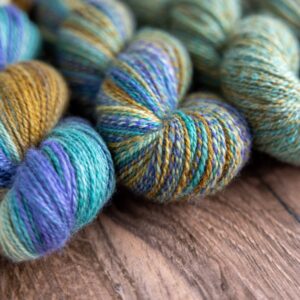(204) One Handpainted Braid – Six Different Color Effects ~ CLOSED

Handpainted braids are wonderful sources of inspiration. Although much of the color work has been done by the dyer, it is up to you, the spinner, to effectively manage the color. In this workshop you will learn six color management techniques, which lend your handspun a greater sense of balance, proportion and unity.
Using non-traditional methods, Kim will share how she prepares rovings and rolags on blending boards and handcards. Her methods will help you to reduce waste, produce the smoothest fiber preparation possible, save time, manage color placement, and create repeatable color effects in your handspun yarns.
Instructor:
Experience Level:
Beginner
Maximum Class Size:
12
Materials fee:
$35 covers 100 grams of handpainted braid, 30 grams of natural white wool, small amounts of natural colored wool and silks to embellish rovings and rolags
Equipment required
Spinning Wheel, Lazy Kate, Fiber Prep Tools
Student Supplies:
SPINNING WHEEL
- Either treadle wheel or e-spinner*. Scotch tension or double drive wheels are recommended. All levels welcome. Spinner should have a solid working knowledge of their wheel and be able to confidently spin a continuous yarn. *Note: If you will be using an e-spinner, remember to bring a battery pack or extension cord.
- Spinning wheel bobbins: Please ensure bobbins are ready to go and cleared of old projects. 3 bobbins are ideal. You will need 1 minimum.
- Leaders: One leader, approximately 2 yards long, for each bobbin.
- Lap cloth (optional): A smooth lap cloth helps to keep fiber tidy and makes for a nicer end product.
- Kate: A Kate or a container outfitted with 2 knitting needles that fit through your bobbins to use for plying.
- Bobbin Winder: You are welcome to use your preferred plying method for this class. We will be spinning for two-ply yarns. I transfer my singles to 2 flanged Leclerc styrene spools (sectional weaving bobbins) before plying. Styrene or cardboard spools, are available through most weaving suppliers. I transfer singles from my spinning wheel bobbin to the flanged spools via either a hand cranked weaving bobbin winder or spinning wheel bobbin winder. Alternatively, for the class you can use a ball winder and two cardboard toilet rolls or your own preferred plying method and equipment.
- Other Spinning Wheel Accessories: Please bring any other accessories you normally require such as a threading hook, small side table, etc.
- Wheel maintenance kit specific to your wheel’s requirements such as lubricant, spare drive band, spare brake band, screwdriver, etc.
CARDING EQUIPMENT:
- Handcards or blending board. My handcards are Schacht 72 pt and my blending board is an Ashford 108 pt
- Two smooth dowel rods, approx. 1/2″- 5/8″diameter. If you purchased a blending board kit equipped with dowels, you will be able to use the dowels from your kit.
- One metal knitting needle, size 6mm / 10 US
- Blending board brush, flicker, or dog brush
- Trigger clamp to secure your blending board or a handcard to a table.
- Rubber mat to prevent equipment from slipping as you doff fibre from the clamped handcard or blending board.
DIZ
- Bring any dizzes you own. I will have dizzes for students to use during the workshop if they don’t own one. If they decide they wish to purchase a diz like mine, they can be purchased for $15.
NOTE TAKING MATERIALS:
- 3-ring binder
- Index cards, any size
- Single hole punch or tape for attaching sample yarns and fibers
- Plastic bags for samples
- Measuring tape or ruler
- Scissors
- Phone or iPad to take photos
Homework:
No Homework.
